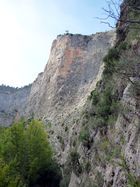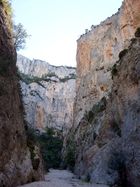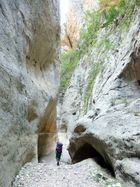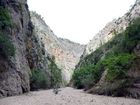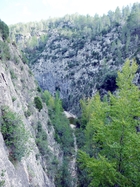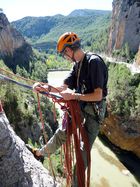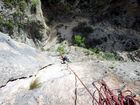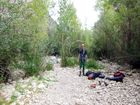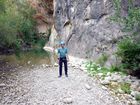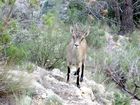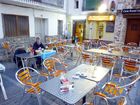October 2014. Report by: Bryan Rynne
Present:
- Bryan Rynne
- Patrick Winter.
Most years Patrick and I head off somewhere for some multi-pitch climbing (either sports or using modern, high-tech protection). This year we decided to go to Montanejos, a small village about 60 miles north-west of Valencia. Montanejos was once a major climbing venue, but it languished for a long time with a poor guide and a need for many of the routes to be re-equipped, and seems to be very quiet nowadays. However, local climber Ernesto Lopez, who runs a refugio just on the edge of town, has now re-equipped many routes, and published a new, very good, climbing guide in 2007 (we bought the guide from him). We had been there for a look, and had a very good day's climbing, a couple of years ago, at the recommendation of Jane and Stuart Murdoch, and wanted to return to have a full week there.
Most of the climbing is on the walls of a long, narrow, steep-sided gorge, with routes of 100-200 metres, or in a subsidiary gorge. The walls of the gorge look very steep and high, partly due to how narrow it is, but also because they are very steep. It would be a climbing paradise here if you could climb hard grade 7's - you could easily climb here for 6 months without running out of things to do. Unfortunately, Patrick and I don't climb hard grade 7's. In fact, although we have often done 6b's and some 6c's in Costa Blanca, we found that 6a was pretty tough here, and 6a+ was about our limit. Once we had recalibrated our expectations we had a very good week here, cherry picking a selection of the local classics, roughly 100-150m, 4-6 pitch routes, mostly containing 6a+ pitches, together with plenty of single pitch stuff.
The rock is mostly steep, pocketed technical limestone, although a couple of the long routes featured some exciting diedres and aretes. One of the best routes of the week was Diedro Del Negre, 165m 6b(6a+ Oblig.) featuring about 60m of sustained, strenuous laybacking up the diedre - fortunately it was well-bolted! In fact, almost all the routes we did here were well bolted, although there is also 'trad' available if you want it. We also did the first three pitches of another local classic: La Luna, max 6b/6b+? which offered very steep but superb climbing on good holds. At the top of the third pitch of this much sought after route there is a spacious ledge, complete with a small wooden bench to allow climbers to have lunch and admire the wonderful view before continuing, or in our case abbing off. Extremely civilized - if the belayer had a belay device featuring a guide mode it would be possible to sit with your feet up admiring the view, occasionally pulling the rope in when a cry of 'take in - PLEASE!!' wafts up from below.
Another excellent route, which we did on our previous visit, is Pericondrio Tragal, 6b, 150m, containing a stunning, very exposed, rising traverse. This is in the Pericondrio sector, in a subsidiary gorge above a stream, and opposite the road, which is tunneled through the rock about 50 metres above the stream. The routes here are accessed by walking across a dam. Rather than doing the same route again, we went to the same starting point and did Trilitate, 6a+, 100m, 4 pitches. This was not as good as Pericondrio Tragal, but very good nevertheless.
We finished the week with Cornelius Moliarte, 6a+, 160m, 5 pitches (the first pitch to get to the start, which wasn't strictly part of the route, would have been a tough 6b+ in Costa Blanca). A very good climb with continued interest and varied climbing, which drifted up and rightwards across a steep wall - presumably looking for the easiest line, since everything else around here was harder.
The sun shone the whole week, and even though it was the second week of October some days were almost 30 degrees. Fortunately, the mornings were cool, and due to the very meandering nature of the gorge, with its high walls, it was often possible to pick climbs and times of day when it wasn't too hot - we got this wrong on day two by going to Placa del Sol in the middle of the day (the name should have told us something), but we didn't make that mistake again.
Getting to the climbs is very easy. The gorge starts on the edge of town, literally 5 minutes walk from our apartment, and the first climbs at Sector Iniciation are another 5 minutes walk from the road. The furthest we walked was 30 minutes, and this was along an almost horizontal track through the gorge, so not a hard approach! Descent is usually by abseil, although some routes do finish at the top of the gorge, and it is possible to walk back to the town from there (not back to the start of the climbs though, unless you walk back up the gorge again).
Montanejos itself is a small spa town with a scenic, gently meandering river flowing along the edge of the town, with water apparently at 25 degrees. It has a modestly thriving tourist industry centred around pensioners coming to swim, or wallow, in the hot spring water. Patrick and I decided to forgo the pleasures of all this. However, this means that there is quite a bit of accommodation here. We stayed in a good, well-equipped apartment, less than two minutes from the town square (well, most of the town is less than two minutes from the town square), which contained a very pleasant bar serving good food. There, of course, also the refugio. This has accommodation and does very good pizzas, when it is open, which does not seem to be often.
Overall, I would say this an excellent place to go, although some of my finger joints are still aching. We had a very good week there.
